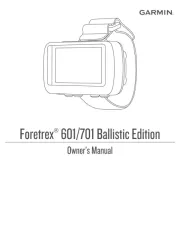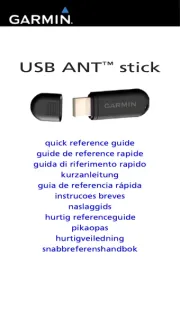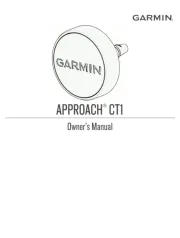Garmin Lidar Lite v3 Handleiding
Garmin
Niet gecategoriseerd
Lidar Lite v3
Bekijk gratis de handleiding van Garmin Lidar Lite v3 (14 pagina’s), behorend tot de categorie Niet gecategoriseerd. Deze gids werd als nuttig beoordeeld door 332 mensen en kreeg gemiddeld 3.7 sterren uit 166.5 reviews. Heb je een vraag over Garmin Lidar Lite v3 of wil je andere gebruikers van dit product iets vragen? Stel een vraag
Pagina 1/14

1
Lidar Lite v3 Operation Manual
and Technical Specications
Laser Safety
WARNING
This device requires no regular maintenance. In the event that the device
becomes damaged or is inoperable, repair or service must be handled by
authorized, factory-trained technicians only. Attempting to repair or service
the unit on your own can result in direct exposure to laser radiation and the
risk of permanent eye damage. For repair or service, contact your dealer or
Garmin® for more information. This device should not be modied or operated
without its housing or optics. Operating this device without a housing and
optics, or operating this device with modied housing or optics that expose the
laser source, may result in direct exposure to laser radiation and the risk of
permanent eye damage. Removal or modication of the diffuser in front of the
laser optic may result in the risk of permanent eye damage.
Use of controls or adjustments or performance of procedures other than those
specied in this documentation may result in hazardous radiation exposure.
Garmin is not responsible for injuries caused through the improper use or
operation of this product.
CAUTION
This device emits laser radiation. This Laser Product is designated Class 1
during all procedures of operation. This designation means that the laser is
safe to look at with the unaided eye, however it is advisable to avoid looking
into the beam when operating the device and to turn off the module when not
in use.
Documentation Revision Information
Rev Date Changes
0A 09/2016 Initial release
Table of Contents
Lidar Lite v3 Operation Manual and Technical Specications ������� 1
Laser Safety ......................................................................................................1
Documentation Revision Information ................................................................. 1
Specications ������������������������������������������������������������������������������������� 2
Physical .............................................................................................................2
Electrical ............................................................................................................2
Performance ......................................................................................................2
Interface .............................................................................................................2
Laser ..................................................................................................................2
Connections ���������������������������������������������������������������������������������������� 2
Wiring Harness ..................................................................................................2
Connector ..........................................................................................................2
Connector Port Identication .......................................................................2
I2C Connection Diagrams .................................................................................3
Standard I2C Wiring ....................................................................................3
Standard Arduino I2C Wiring .......................................................................3
PWM Wiring ................................................................................................. 3
PWM Arduino Wiring....................................................................................3
Operational Information ��������������������������������������������������������������������� 4
Technology ........................................................................................................4
Theory of Operation ...........................................................................................4
Interface .............................................................................................................4
Initialization ..................................................................................................4
Power Enable Pin ........................................................................................4
I2C Interface ................................................................................................4
Mode Control Pin .........................................................................................4
Settings ........................................................................................................ 4
I2C Protocol Information �������������������������������������������������������������������� 6
I2C Protocol Operation ......................................................................................7
Register Denitions ...........................................................................................7
Control Register List ....................................................................................7
Detailed Control Register Denitions ........................................................... 8
Frequently Asked Questions ����������������������������������������������������������� 12
Must the device run on 5 Vdc? Can it run on 3.3 Vdc instead? ....................... 12
What is the spread of the laser beam? ............................................................ 12
How do distance, target size, aspect, and reectivity effect returned signal
strength? ..........................................................................................................12
How does the device work with reective surfaces? .......................................12
Diffuse Reective Surfaces ........................................................................12
Specular Surfaces .....................................................................................12
How does liquid affect the signal? ...................................................................13

2
Specications
Physical
Specication Measurement
Size (LxWxH) 20 × 48 × 40 mm (0.8 × 1.9 × 1.6 in.)
Weight 22 g (0.78 oz.)
Operating temperature -20 to 60°C (-4 to 140°F)
Electrical
Specication Measurement
Power 5 Vdc nominal
4.5 Vdc min., 5.5 Vdc max.
Current consumption 105 mA idle
135 mA continuous operation
Performance
Specication Measurement
Range (70% reective
target)
40 m (131 ft)
Resolution +/- 1 cm (0.4 in.)
Accuracy < 5 m ±2.5 cm (1 in.) typical*
Accuracy ≥ 5 m ±10 cm (3.9 in.) typical
Mean ±1% of distance maximum
Ripple ±1% of distance maximum
Update rate (70%
Reective Target)
270 Hz typical
650 Hz fast mode**
>1000 Hz short range only
Repetition rate ~50 Hz default
500 Hz max
*Nonlinearity present below 1 m (39.4 in.)
**Reduced sensitivity
Interface
Specication Measurement
User interface I2C
PWM
External trigger
l2C interface Fast-mode (400 kbit/s)
Default 7-bit address 0x62
Internal register access & control
PWM interface External trigger input
PWM output proportional to distance at 10 μs/cm
Laser
Specication Measurement
Wavelength 905 nm (nominal)
Total laser power
(peak)
1.3 W
Mode of operation Pulsed (256 pulse max. pulse train)
Pulse width 0.5 μs (50% duty Cycle)
Pulse train repetition
frequency
10-20 KHz nominal
Energy per pulse <280 nJ
Beam diameter at
laser aperture
12 × 2 mm (0.47 × 0.08 in.)
Divergence 8 mRadian
Connections
Wiring Harness
Wire Color Function
Red 5 Vdc (+)
Orange Power enable (internal pull-up)
Yellow Mode control
Green I2C SCL
Blue I2C SDA
Black Ground (-)
There are two basic congurations for this device:
• —a serial computer bus used to I2C (Inter-Integrated Circuit)
communicate between this device and a microcontroller, such as an
Arduino board .(“I2C Interface”, page 4)
• —a bi-directional signal transfer method PWM (Pulse Width Modulation)
that triggers acquisitions and returns distance measurements using the
mode-control pin .(“Mode Control Pin”, page 4)
Connector
You can create your own wiring harness if needed for your project or
application. The needed components are readily available from many
suppliers.
Part Part NumberDescription Manufacturer
Connector
housing
6-position, rectangular housing,
latch-lock connector receptacle with
a 1.25 mm (0.049 in.) pitch.
JST GHR-06V-S
Connector
terminal
26-30 AWG crimp socket connector
terminal (up to 6)
JST SSHL-002T-P0.2
Wire UL 1061 26 AWG stranded copper N/A N/A
Connector Port Identication
➏
➊
Item Pin Function
➊1 5 Vdc (+)
2 Power enable (internal pull-up)
3 Mode control
4 I2C SCL
5 I2C SDA
➏6 Ground (-)

3
I2C Connection Diagrams
Standard I2C Wiring
➋
➎
➌
➊
➍
Item Description Notes
➊680µF electrolytic capacitor You must observe the correct polarity when
installing the capacitor.
➋Power ground (-) connection Black wire
➌I2C SDA connection Blue wire
➍I2C SCA connection Green wire
➎5 Vdc power (+) connection Red wire
The sensor operates at 4.75 through 5.5 Vdc,
with a max. of 6 Vdc.
Standard Arduino I2C Wiring
➋
➎
➌
➊
➍
Item Description Notes
➊680 F electrolytic capacitor You must observe the correct polarity when µ
installing the capacitor.
➋I2C SCA connection Green wire
➌I2C SDA connection Blue wire
➍Power ground (-) connection Black wire
➎5 Vdc power (+) connection Red wire
The sensor operates at 4.75 through 5.5 Vdc,
with a max. of 6 Vdc.
PWM Wiring
➋
➏
➌
➊
➎
➍
Item Description Notes
➊Trigger pin on microcontroller Connect the other side of the resistor to the
trigger pin on your microcontroller.
➋Monitor pin on microcontroller Connect one side of the resistor to the mode-
control connection on the device, and to a
monitoring pin on your microcontroller.
➌Power ground (-) connection Black Wire
➍1kΩ resistor
➎Mode-control connection Yellow wire
➏5 Vdc power (+) connection Red wire
The sensor operates at 4.75 through 5.5 Vdc,
with a max. of 6 Vdc.
PWM Arduino Wiring
➋
➎
➌
➊
➍➏
Item Description Notes
➊5 Vdc power (+) connection Red wire
The sensor operates at 4.75 through 5.5 Vdc,
with a max. of 6 Vdc.
➋Power ground (-) connection Black Wire
➌Mode-control connection Yellow wire
➍Monitor pin on microcontroller Connect one side of the resistor to the mode-
control connection on the device, and to a
monitoring pin on your microcontroller.
➎Trigger pin on microcontroller Connect the other side of the resistor to the
trigger pin on your microcontroller.
➏1kΩ resistor
Product specificaties
| Merk: | Garmin |
| Categorie: | Niet gecategoriseerd |
| Model: | Lidar Lite v3 |
Heb je hulp nodig?
Als je hulp nodig hebt met Garmin Lidar Lite v3 stel dan hieronder een vraag en andere gebruikers zullen je antwoorden
Handleiding Niet gecategoriseerd Garmin

11 Augustus 2025

7 Mei 2025

25 Februari 2025

9 Januari 2025

9 Januari 2025

14 December 2024

13 November 2024

2 Oktober 2024

23 Juli 2024

25 Juni 2024
Handleiding Niet gecategoriseerd
- Tactical Fiber Systems
- Miracle Smile
- Akrobat
- Ultimate Support
- IBEAM
- Earthquake Sound
- On-Stage
- Gamdias
- Pyle
- SiriusXM
- Belkin
- OnTruss
- Bellari
- Jocel
- Cropico
Nieuwste handleidingen voor Niet gecategoriseerd

14 September 2025

14 September 2025

13 September 2025

13 September 2025

13 September 2025

13 September 2025

13 September 2025

13 September 2025

13 September 2025

13 September 2025